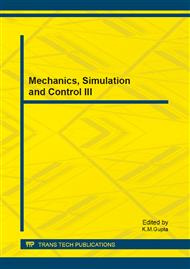[1]
J. Holmes and W. Holmes: Speech Synthesis and Recognition, 2nd Edition, Taylor & Francis, N.Y. (2001).
Google Scholar
[2]
D. Jurafsky and J.H. Martin: Speech and Language Processing. An Introduction to Natural Language Processing, Computational Linguistics, and Speech Recognition, Second Edition, Pearson Prentice Hall, (2008).
DOI: 10.1162/coli.b09-001
Google Scholar
[3]
S. McLaughlin and P. Maragos: Nonlinear methods for speech analysis and synthesis. In: Marshall S, Sicuranza G, editor. Advances in nonlinear signal and image processing, Vol. 6. Hindawi Publishing Corporation (2007), p.103.
Google Scholar
[4]
V. Pitsikalis and P. Maragos: Analysis and classification of speech signals by generalized fractal dimension features, Speech Communication, Vol. 51, no. 12, (2009), p.1206–1223.
DOI: 10.1016/j.specom.2009.06.005
Google Scholar
[5]
K. Sreenivasa Rao: Role of neural network models for developing speech systems, Sadhana Vol. 36, Part 5, (2011 Oct), p.783–836.
DOI: 10.1007/s12046-011-0047-z
Google Scholar
[6]
E.V. Raghavendra, P. Vijayaditya and K. Prahallad: Speech synthesis using artificial neural networks, National Conference on Communications (NCC), Chennai, India, (2010), pp.1-5.
DOI: 10.1109/ncc.2010.5430190
Google Scholar
[7]
O. Karaali, G. Corrigan, and I. Gerson: Speech Synthesis with Neural Networks, World Congress on Neural Networks, San Diego, (1996 Sep), pp.45-50.
Google Scholar
[8]
W. K. Lo and P. C. Ching: Phone-Based Speech Synthesis With Neural Network And Articulatory Control, In Proceedings of Fourth International Conference on Spoken Language (ICSLP 96), (1996), vol. 4, pp.2227-2230.
DOI: 10.1109/icslp.1996.607248
Google Scholar
[9]
I. Gerson, O. Karaali and G. Corrigan: Neural Network Speech Synthesis, In Proceedings of the World Conference on Neural Networks, San Diego, California, USA, (1996), pp.45-50.
Google Scholar
[10]
M. Malcangi and D. Frontini: A Language-Independent Neural Network-Based Speech Synthesizer. In: Neurocomputing, 73: 1-3 (2009 Dec), pp.87-96.
DOI: 10.1016/j.neucom.2008.08.023
Google Scholar
[11]
S.D. Balkin: Using Recurrent Neural Networks for Time Series Forecasting, Technical Report 97-11, Pennsylvania State University, (1997).
Google Scholar
[12]
R.J. Frank, N. Davey and S.P. Hunt: Time Series Prediction and Neural Networks. In: Journal of Intelligent and Robotic Systems 31, (2001), pp.91-103.
Google Scholar
[13]
W. Kinzel: Predicting and generating time series by neural networks: An investigation using statistical physics. In: Computational Statistical Physics (2002), pp.97-111.
DOI: 10.1007/978-3-662-04804-7_6
Google Scholar
[14]
A. Priel and I. Kanter: Time series generation by recurrent neural networks, In: Annals of Mathematics and Artificial Intelligence 39 (2003), p.315–332.
DOI: 10.1023/a:1024620813258
Google Scholar
[15]
M. Crisan: New Aspects of Phoneme Synthesis Based on Chaotic Modeling, In: Proceedings of 2011 International Conference on Instrumentation, Measurement, Circuits and Systems (ICIMCS 2011), Hong Kong, pp.605-614.
DOI: 10.1007/978-3-642-27334-6_71
Google Scholar


